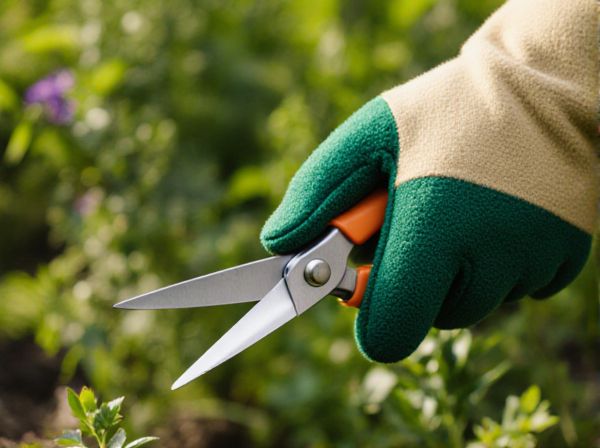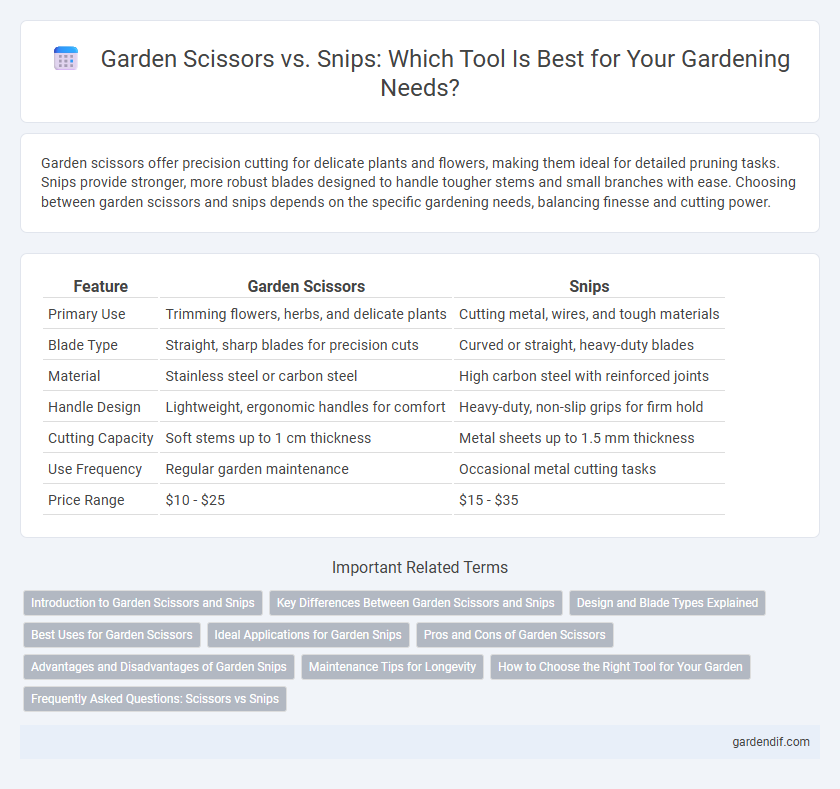
Garden scissors vs snips Illustration
Garden scissors offer precision cutting for delicate plants and flowers, making them ideal for detailed pruning tasks. Snips provide stronger, more robust blades designed to handle tougher stems and small branches with ease. Choosing between garden scissors and snips depends on the specific gardening needs, balancing finesse and cutting power.
Table of Comparison
| Feature | Garden Scissors | Snips |
|---|---|---|
| Primary Use | Trimming flowers, herbs, and delicate plants | Cutting metal, wires, and tough materials |
| Blade Type | Straight, sharp blades for precision cuts | Curved or straight, heavy-duty blades |
| Material | Stainless steel or carbon steel | High carbon steel with reinforced joints |
| Handle Design | Lightweight, ergonomic handles for comfort | Heavy-duty, non-slip grips for firm hold |
| Cutting Capacity | Soft stems up to 1 cm thickness | Metal sheets up to 1.5 mm thickness |
| Use Frequency | Regular garden maintenance | Occasional metal cutting tasks |
| Price Range | $10 - $25 | $15 - $35 |
Introduction to Garden Scissors and Snips
Garden scissors and snips are essential horticultural tools designed for precision pruning and trimming tasks. Garden scissors typically feature longer blades and handles for cutting larger stems and branches, while snips offer smaller, sharper blades ideal for delicate tasks such as deadheading flowers and harvesting herbs. Both tools improve plant health and aesthetics by enabling clean cuts that minimize damage and promote faster healing.
Key Differences Between Garden Scissors and Snips
Garden scissors feature longer, straight blades ideal for trimming flowers and small branches with precision, while snips have shorter, curved blades designed for cutting tougher materials like wire and thick stems. The ergonomic handle design of snips offers enhanced grip and leverage, making them suitable for heavy-duty tasks compared to the lightweight garden scissors. Blade material varies, with garden scissors often using stainless steel for rust resistance and snips utilizing hardened steel for durability and cutting strength.
Design and Blade Types Explained
Garden scissors typically feature long, straight blades designed for precise cutting of flowers and small stems, offering clean and accurate trims. Snips often boast shorter, curved blades that enhance control and leverage for detailed cutting tasks such as pruning herbs or shaping plants. Blade materials vary from stainless steel for rust resistance to carbon steel for sharper edges, influencing tool durability and performance in diverse gardening applications.
Best Uses for Garden Scissors
Garden scissors excel in precision pruning, ideal for trimming delicate flowers and light foliage without damaging stems. Their sharp, fine blades allow for detailed shaping of herbs, roses, and bonsai plants, ensuring clean cuts that promote healthy growth. These scissors are best suited for gardeners seeking control and finesse in small-scale trimming tasks.
Ideal Applications for Garden Snips
Garden snips excel in precision tasks such as trimming flower stems, harvesting herbs, and deadheading small plants where control and delicacy are crucial. Their compact design and sharp, pointed blades make them ideal for accessing tight spaces and performing detailed pruning without damaging surrounding foliage. These tools are preferred for intricate garden work requiring accuracy rather than bulk cutting.
Pros and Cons of Garden Scissors
Garden scissors offer precise cutting capability for delicate plants and detailed pruning tasks, making them ideal for shaping flowers and trimming herbs. Their ergonomic design reduces hand fatigue during prolonged use, but they may lack the strength required for tougher branches compared to snips. Limited blade length can restrict their effectiveness on larger stems, posing a challenge for gardeners needing versatile cutting tools.
Advantages and Disadvantages of Garden Snips
Garden snips offer precise cutting for detailed pruning tasks thanks to their small, sharp blades, making them ideal for trimming flowers, herbs, and small stems. Their lightweight design provides excellent control and reduces hand fatigue, but the limited blade length restricts their effectiveness on thicker branches. Snips also tend to require frequent sharpening to maintain cutting efficiency compared to more robust garden scissors.
Maintenance Tips for Longevity
Regularly clean garden scissors and snips after each use to remove sap and dirt, preventing rust and maintaining sharpness. Apply a light coat of oil to the blades and pivot points to reduce friction and protect against corrosion. Store tools in a dry, cool place, and periodically sharpen blades to ensure efficient cutting performance and extend their lifespan.
How to Choose the Right Tool for Your Garden
Garden scissors are ideal for precise trimming of delicate plants and flowers, offering fine control and sharp, narrow blades designed for detail work. Snips, featuring stronger, broader blades and ergonomic handles, are better suited for cutting thicker stems, small branches, and tougher materials in the garden. Choosing the right tool depends on the thickness and type of plant material, with garden scissors preferred for finesse and snips favored for durability and power.
Frequently Asked Questions: Scissors vs Snips
Garden scissors are typically designed for lighter trimming tasks with precision, featuring straight blades ideal for cutting leaves and flowers, whereas snips offer stronger, curved blades suited for tougher materials like small branches or wire. Frequently asked questions highlight that scissors provide finer control for detailed garden work, while snips deliver greater cutting power and durability essential for pruning and heavier-duty tasks. Users often ask about blade type, ergonomic design, and suitable applications to choose the right tool for specific gardening needs.
Garden scissors vs snips Infographic

 gardendif.com
gardendif.com